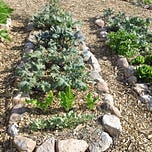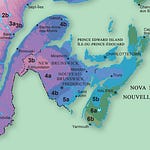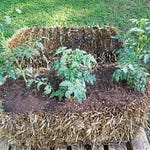Have you always wanted a garden, but seem to watch each year roll by only to realize at some point that it's too late? You aren't alone. The prospect of getting started can be overwhelming and, if you aren't sure where or how to begin, this three-part series will set you on a path to finally realize that goal.
I think that many people like the idea of having a garden, and have visions of top-quality, organic food available right out the back door. Regardless of the source of that vision — whether it be fond childhood memories, a desire for a greater connection to our food, a frugal compulsion to maximize the value that can be realized from land ownership or a desire for an idealized horticultural aesthetic — that garden must start somewhere.
If you're just starting out, restarting, or in the mood to try something new, a garden designed to employ permaculture principles has a lot to offer the gardener who wants a garden that will always give more than it takes. Permaculture gardens do this by copying the systems that exist in nature.
Since this series is about "getting started" I thought that I would give a concise crash course in how to design a very simple gardening space that employs some basic permaculture principles, without getting into the finer details of permaculture (which could easily fill a book). The first step in getting started is finding the right spot, which requires some very important considerations.
Sun
Everything that grows in your garden needs sunlight, and the more the better. Six hours of direct sunlight would be a minimum, and even then, some heat-loving plants such as tomatoes, peppers and eggplants may not grow to maturity in a season without at least eight or more hours of sunlight. I see so many people plant their garden where THEY want it to be, rather than where the PLANTS want to grow. If you are serious about wanting a productive, low maintenance garden, locate the plants where they will get the most sun possible given the space that you have. Have a look at your property at the different times of the day and make a note of where the sun hits the ground. Try to find the place where most of the sun is, most of the time, and your plants will be happy.
These bush beans started producing a bowlful every two days in July and kept producing right up into September.
Wind
Another consideration in choosing the right spot is finding reasonable protection from wind. Strong winds can break large plants, smash trellises, or cause things to fly around in your garden that will break other things. Wind chill can also reduce soil temperatures to unseasonable levels, delaying germination and harvests.
Grade
The slope of the ground where you intend to garden is also important. The ideal garden site is level - though a slight slope is ok in most circumstances. In my experience, if heavy rains are common in your area (as they are here in Nova Scotia), you will want level beds, because heavy rains + sloping ground = running water. You do not want a river running through your garden, especially in the spring when rains are frequent and seedlings are vulnerable. Having said all of this, you have to work with what you've got, so if the slope of your land is less than ideal (my garden slopes toward the east) you can compensate by designing beds that compensate for the existing grade.
The ideal garden site is level - though a slight slope is ok in most circumstances.
Final Thoughts
So that's the first step toward starting a successful garden: survey your property, and choose the spot that gets the most sun, the least wind and is the most level. Some might think it odd that I have left "soil" out of the discussion. Indeed, good soil is crucial, but as you will find in my next article, this is perhaps the one element over which we can exert the most influence. By employing simple permaculture techniques, it is entirely possible to take very poor soils and bring them back to life.














